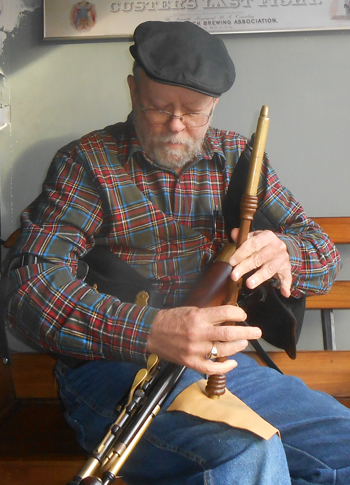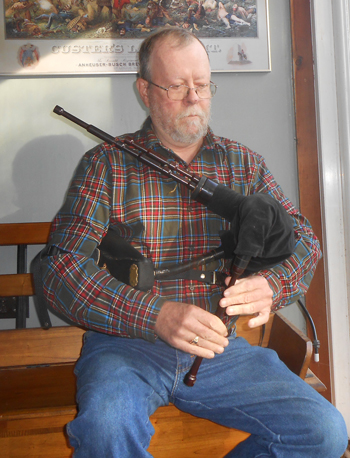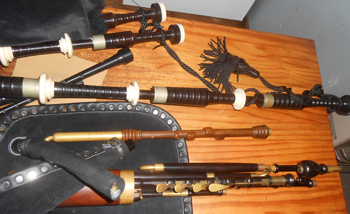Bagpipes of Maine
by Tom Seymour

Piper Tom Seymour playing Uilleann pipes. Fingering the chanter and operating one of the four regulators with the heal of the right hand. The bag that provides the air is under the right elbow. Tom Seymour photo
It’s Fourth of July, or perhaps Memorial Day, and parade watchers hear distant drums and the faint buzz of Highland bagpipes. And on they come, clad in Kilts, tassels swinging, marching in perfect step to Scotland The Brave and other Tunes of Glory. No matter a person’s nationality, this Scottish sound reaches deep into the soul, compelling and beckoning the hearer to become part of the overall pageantry.
But marching bands and Highland bagpipes are only one facet of a larger jewel. Other pipes and other kinds of pipers are alive and well in Maine.
Scottish Smallpipes
The 1985 release of Hamish Moore’s record album Cauld Wind Pipes signaled the beginning of a renaissance for small, bellow-blown bagpipes. Moore’s instrument of choice, Scottish smallpipes, work well with other traditional instruments such as fiddle, whistle and guitar. In addition to these standard accompaniments, Moore surprised the music world when he recorded The Mill, The Mill Oh, inside a water-operated gristmill. The paddles and wooden gears beat a unique and steady rhythm to Moore’s rendition of this classic tune. Moore also incorporated an Australian instrument, the digery-doo on an album cut.
Scottish smallpipes were on the verge of extinction when Moore’s music hit the world. Because of the newfound popularity of smallpipes, people began perusing ancient manuscripts for examples of sheet music specific to smallpipes. And pipe makers began studying examples of existing pipes and finally, making their own, brand-new smallpipes.
Scottish smallpipes, or lowland pipes, differ from Highland bagpipes in that while drones (those long things that make the steady sound) on Highland pipes are separate from each other and tied together by means of a special cord, drones on smallpipes all come out of a common stock, or special fitting tied into the bag.
Instead of putting the drones over the shoulder as with Highland pipes, smallpipe players typically rest the drones over their right arm. A few players let their drones stand nearly straight, resting on the shoulder.
Also different from Highland pipes, Scottish smallpipes are traditionally kept inflated by a bellows. Pipe bellows are strapped to the body and the top section, or “cheek” of the bellows has a fastener to attach it to the player’s arm. Thus the player keeps the pipe bag filled with air by raising and slowly lowering the bellows arm.
Bellows use an inner valve that allows the bag to take in air on the upstroke. Then on the downstroke, the valve closes and the air is forced through a flexible tube and into the pipe bag. One of the more difficult aspects of playing in this style is that it takes considerable concentration to keep the bag inflated while playing steadily. But like anything else, it can be mastered with time.
The two most common keys for Scottish smallpipes are D and A. An A smallpipe has a mellow, smooth sound and is the key used by instructors in schools in Scotland. The key of D is more strident and aggressive. Both have their special uses.
In the 30 years since Hamish Moore re-introduced Scottish smallpipes to the world, pipe makers have made names for themselves with their offerings of Scottish smallpipes. Maine has its share of smallpipe makers, among them is Michael Dow, of York, Maine. Dow is Maine’s oldest pipe maker, having made instruments commercially since 1992. Dow prides himself on being Maine’s only native bagpipe maker.
Michael Dow began by copying museum artifacts, the type used 200 to 250 years ago. However, Dow says that pipes he made then and now bear little resemblance to those early sets. Dow says that his innovations resulted from his careful study of those early sets and that his modifications are designed to minimize problems pipers may encounter. Most of Michael Dow’s Scottish smallpipes are sold domestically. These are primarily in the key of A.
Dow also makes bellows and these are in demand worldwide. Dow bellows are a lifetime investment. Sturdy and dependable, these airtight bellows have found favor with all kinds of pipers. For example, noted Uilleann piper Jerry O’ Sullivan uses Dow bellows.
Michael Dow’s contact information: Architectural Woodcarving LLC, Michael A. Dow, 27 Pudding Lane, York, Maine 03909; (207) 363-7924; madow@maine.rr.com; http://www.archcarving.com/.

The Scottish small pipes. Chanter played with both hands. The bellows providing the air to the chanter and drones (over right shoulder) are behind the right elbow. Tom Seymour photo
Uilleann Pipes
It’s doubtful that anyone seeing the word “Uilleann” for the first time could pronounce it correctly. Phonetically, it would be presented as “Ill-in.” And Uilleann in Gaelic refers to “elbow.” Thus Uilleann pipes are “elbow pipes,” meaning that the elbow works the bellows that supply air to the bag.
An instrument of Ireland, Uilleann pipes were widely played not only in their native land, but also in America during the early 20th century. But like Scottish smallpipes, Uilleann pipes fell into a long period of disuse. And also like Scottish smallpipes, Uilleann pipes have experienced a worldwide rebirth.
Unlike either Highland pipes or Scottish smallpipes, Uilleann pipes are capable of two octaves. Both Scottish pipes barely form one octave with their nine-note chanters.
But that’s not all. Uilleann pipes incorporate something called “regulators,” devices that sit alongside the drones in the common stock. A full set of Uilleann pipes includes tenor, baritone and bass regulators. Many pipers, however, content themselves with tenor and baritone regulators because bass regulators are somewhat difficult to reach.
Regulators have keys, the same as other keyed wind instruments. These are played so as to introduce harmonies into the tunes and also, to add a wide variety of corresponding rhythms to a tune.
The heart of an Uilleann pipe is the chanter and the heart of the chanter is the reed. These are similar to oboe reeds, two-sided and made of cane. Chanter reeds are the bugaboo of beginning pipers. These reeds vary with changes in humidity. Some pipers, the author included, run a home humidifier in winter to keep pipes in the playable range.
While a superb solo instrument, Uilleann pipes, like Scottish smallpipes, work well in concert with other instruments such as fiddle, whistle, Irish flute, bouzouki (a Greek stringed instrument that the Irish have “appropriated” to their use, especially on fast jigs and reels) and guitar. Irish musical groups often have rhythmic support from a bohdran, an Irish hand drum played by a two-ended beater, or “tipper.”
It’s always best to hear any instrument live, but thankfully for we here in Maine, some excellent recordings exist of all the different pipes, including Uilleann pipes. Also, different Irish folk bands feature Uilleann pipes along with the other instruments. Names like The Chieftains, Battlefield Band and Planxty roll quickly off the tongue when thinking of Irish bands with excellent Uilleann piping.
Na Piobairi Uilleann, a worldwide Uilleann piping organization based in Dublin, Ireland, offers memberships to pipers from around the world. Their excellent website features categories such as piping instruction videos by world-famous pipers, used pipes, a tune library and much more.
Anyone who has not heard the sound of Uilleann pipes should visit the NPU website and prepare to be amazed.
Contact information for NPU is: Na Piobairi Uilleann, 15 Henrietta Street, Dublin, Ireland; (353) (1) 873-0537; info@pipes.ie; www.pipers.ie.
While the number of Uilleann pipers in Maine is steadily growing, they fall far short of the number of those who play Highland bagpipes. Uilleann pipes require much care to detail and also, careful attention to the overall sound. Try squeezing the bag, working the bellows, fingering the chanter and in addition to all that, using the heel of the palm of the lower hand on the bottom of the chanter to play harmonies and cordwork on the regulators. It seems an impossible task.
It’s tough and time consuming, but when it all comes together any difficulties or reed problems are quickly forgotten. Uilleann pipes can play anything from snappy jigs, compelling reels and the most haunting, heart-rending airs of any instrument.
Most Uilleann pipers practice every day. The author aims for between one and two hours daily. It takes at least 45 minutes for a set of Uilleann pipes to settle in and sound as they should. The reeds need to vibrate for some time before they create the desired sound. Even that pales as next to nothing when the pipes finally settle in and chanter notes blend with the drones (tenor, baritone and bass drones ) and regulators punch out complicated patterns that make the listener think, “How did he do that?”
In some communities, various folk musicians get together in sessions. Here, jigs and reels come alive in a huge way, the more instruments the better. And Uilleann pipers love playing in sessions.
As with smallpipes, Maine has its Uilleann pipe makers, one of the most prominent being BC Childress of Kennebunk. Childress makes Uilleann pipes and also repairs and maintains both his own pipes and those made by others. In addition to Uilleann pipes, BC Childress also makes Scottish smallpipes and Northumbrian (a bellows-blown, keyed pipe of the border country between Scotland and England) pipes. A gifted performer, Childress entertains on pipes, guitar, vocals and whistle. Also, Childress gives lessons in the various disciplines.
As an example of what BC Childress can do, the author took a set of Uilleann pipes to Childress last summer. These pipes were playing hard and were very undependable. Childress immediately removed the chanter reed and replaced it with one of his manufacture. The instrument instantly found a new voice.
And then the big one came. Uilleann pipers mostly use bags made of cowhide, and the author’s pipes were no exception. With the bag fully inflated, Childress misted the outside with a soapy water solution. The entire bag began emitting tiny bubbles. It leaked like a sieve. So an order was placed for a new bag, one of Childress’s manufacture. This order also included a set of synthetic drone reeds, also made by Childress. These additions made all the difference in the world and now the author would not part with his set of Uilleann pipes for all the money in the world.
Contact information for BC Childress is: BC Childress Uilleann Pipes, 18 York St., Kennebunk, Maine 04043; (207) 651-0096; bruce@bcpipes.com; www.bcpipes.com.

Scottish Highland Pipes with 3 drones above. Uilleann pipes bottom right with 4 brass regulators. Uilleann chanter center, with bag and connection to the chanter lower left. Tom Seymour photo
Marching Band
Finally, Maine has long had its share of marching bands, pipe-and-drum bands that march on the street and also put on concerts in various venues. A venerable band that has seen activity in not only Maine but also much of the eastern U.S. and Canada, Anah Highlanders out of Bangor, a Shrine band, is always seeking new talent. And better yet, the prospective piper or drummer need not be accomplished, since members of the unit can teach beginners.
While Highland bagpipes seem a complicated thing to learn, the beginner doesn’t set hand on a set of pipes for at least a year. All tunes and all learning takes place on a relatively inexpensive instrument called the practice chanter. These use a plastic reed and are easy to blow.
Highland pipe tunes (as opposed to Uilleann pipe tunes, which are best learned by ear) are learned strictly from the sheet music. Marching bands such as Anah Highlanders play a variety of sprightly marches, although when playing in concert, airs, slow marches and perhaps even a dance tune called a Strathspey comes out.
Naturally, the Highlanders aim is to train new pipers in working with the band and playing tunes in the band’s repertoire. Some band pipers, though, work on more difficult compositions, with the aim of attending competitions held at Highland Games around New England and Canada.
Contact information for Anah Highlanders: Band contact Mike Murphy; pipingleprechaun@hotmail.com; snail mail address: Anah Highlanders, Anah Shrine Hall, 586 Main Street, Bangor, ME 04401.
Lifelong Gift
The gift of piping is something that people cherish all their lives. No matter the pipes, Highland, Scottish smallpipes or Uilleann pipes, there are players living in Maine. So keep an ear out for that distant sound and if you really feel inspired, ask a piper about taking up the instrument. But be warned. Once begun, it’s nearly impossible to walk away from these beautiful and haunting instruments.
History and Differences Among Pipes
by Tom Seymour
Uilleann pipes are a purely Irish form of bagpipes. These pipes came into being in the early 1700s in Ireland and other parts of Britain. The current form took another 50 years to develop.
Uilleann pipes are the most intricate and capable form of bagpipes, with a chanter that can produce two full octaves, something unique to this advanced of pipes.
Uilleann pipes are typical of later types of pipes in that rather than being mouth-blown, they utilize a bellows to pump dry air into the bag. Highland pipes and other mouth-blown pipes must use fairly stiff reeds in order for the reeds to survive the deleterious effects of moisture delivered by human breath. Uilleann pipes, being “dry” pipes, can make good use of finer, thinner reeds and that in turn enables the chanter to produce a wider range of tones, including some quite intrusive and also some very soft and mellow sounds not possible with mouth-blown pipes.
The name “Uilleann pipes” comes from the Gaelic word for “elbow pipes,” and that alludes to the bellows being pumped by a person’s elbow.
Highland Pipes
Far older than Uilleann pipes, Highland pipes are the end product of bagpipe development. Bagpipes of all sorts were known and played down through the ages, including in ancient Egypt and ancient Rome. Chaucer, in his Canterbury Tales of the 14th century, wrote about a bagpipe-playing miller. But the modern form, with two tenor drones and one bass drone, is a Scottish development.
The Highland pipes of Scotland took some time to assume their modern form. Europeans played a form of bagpipe in the 12th century. This consisted simply of a bag and a chanter. But it took another two hundred years for the first drone to complement the overall sound. And at the end of the 15th century, a second drone was added. It is commonly believed that the longer, bass drone was added around 1600, thus forming the Great Highland Bagpipe as it is known in Scotland and around the world today.
As opposed to the Uilleann pipes, whose three drones are tenor, baritone and bass, Highland pipe drones are tenor, tenor and bass. And it is this configuration that the British military adopted. Pipe and drum units saw service in most of Britain’s colonial wars. Additionally, a certain kind of music developed of this English connection. Thus it is that the stirring marches of 2/4, 3/4, 4/4 and 6/8 time came into being.
Competitions in piping also became popular and military units vied with one another as to who was the most competent piper. Today in Scotland and throughout much of the rest of the world, Highland games include not only pipe band competition but also individual, or solo competition.
Scottish Smallpipes
European paintings of the 17th century depict bellows-blown smallpipes being played. By the 18th century, Scottish pipers began playing, among other pipes, bellows-driven smallpipes. Extant examples of these instruments are very rare and few exist. But enough are around for pipe makers to begin making modern instruments based upon the old designs.
Scottish border, or smallpipe playing pretty much died out over the last 100 or more years. But in the 1990s, a revival of large proportions began and people not only sought new Scottish smallpipes, they also became interested in learning to play according to the original technique. The latter was easier said than done until 1995, when Matt Seattle introduced to the piping world a 1733 copy of the Dixon Manuscript.
Here, in this ancient manuscript, was a clear representation of smallpipe tunes, giving an idea of how they were played. From that time on, smallpipes have grown by leaps and bounds. Maine now has a number of makers of Scottish smallpipes.
Persons interested in learning more about the instrument can contact the Lowland and Border Piper’s Society by visiting their website at: www.lbps.net/
